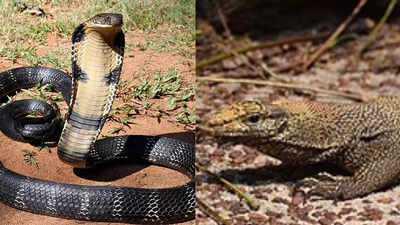King cobra vs monitor lizard: Key differences and who would win in a battle |

The fight between a king cobra and a monitor lizard is an electrifying encounter of venom and brute force. The king cobra, the longest venomous snake in the world, is infamous for its lethal neurotoxic bite, while the monitor lizard uses its razor-sharp claws, powerful jaws, and unexpected agility to kill prey. Both are capable predators, but what do they do when they turn their attention to one another? This battle between two of the best reptiles is an interesting glimpse into nature’s ultimate survival strategies. Continue reading to see who is in control in this classic battle.
King cobra vs monitor lizard: Major differences
1. King cobra vs monitor lizard: Scientific name
The king cobra (Ophiophagus hannah) is the longest venomous snake in the world, with its characteristic hood and aggressive attitude. It is not a real cobra but has its own genus, Ophiophagus, which literally means “snake-eater.” Monitor lizards, however, are part of the Varanus genus, including the water monitor (Varanus salvator) and the Komodo dragon (Varanus komodoensis). These snakes are very adaptive and can be seen throughout Africa, Asia, and Australia. Although the king cobra is a specialist snake, monitor lizards have very varied diets and habitats and are thus very versatile predators.
2. King cobra vs monitor lizard: Size
The king cobra will reach a length of 18 feet (5.5 meters) and is the world’s longest venomous snake. It is, notwithstanding its size, light and very agile, moving by speed and accuracy as much as possible with no brute strength. Monitor lizards, whether species, reach 3 feet to 10 feet (1–3 meters). There are some, the Komodo being one of these, which are huge and built, weighing in excess of 150 pounds. This difference in size is important to potential combat—whereas the king cobra benefits from length, the physical mass of the monitor lizard provides more physical strength.
3. King cobra vs monitor lizard: Venom and bite
The venom of the king cobra is a powerful neurotoxin that incapacitates the nervous system, causing paralysis and eventual suffocation of its victims. It fires multiple bites in close succession to leave its prey in a helpless condition. Monitor lizards, by contrast, lack venom but are equipped with muscular jaws filled with sharp, saw-like teeth. A few such as the Komodo dragon also possess mildly toxic saliva that inflicts blood loss and infection. Whereas the venom of a cobra can immobilize an opponent very fast, the crushing bite of a monitor lizard and its tearing flesh apart pose it as a dangerous opponent.
4. King cobra vs monitor lizard: Defense mechanism
King cobras use intimidation as their main defense. When threatened, they raise themselves up, flare out their hood, and give a low hiss to frighten away a potential threat. Their speed in striking is their last option when intimidation does not work. Monitor lizards, however, employ their muscular tails, powerful claws, and forceful bites to repel. They can also flee by running up trees or swimming away. Other species, such as the Komodo dragon, have bone-crushing bites and are extremely dangerous. Although the king cobra’s venom is toxic, the monitor lizard’s physical strength provides it with good survival skills.
5. King cobra vs monitor lizard: Speed and agility
Although they are enormous, the king cobra and monitor lizard are both very agile and fast. The king cobra attacks at lightning speed, injecting venom and then retreating. It is also a very good climber and swimmer. Monitor lizards, based on the type, are good runners and are capable of attaining speeds of up to 12 mph (20 km/h) on dry land. They are also capable swimmers and use their robust tails for pushing through the water. In a showdown, the king cobra’s quickness enables it to avoid attacks, but the monitor lizard’s speed on various surfaces gives it an advantage in stamina.
6. King cobra vs monitor lizard: Diet
King cobras are expert snake eaters, consuming other snakes, including venomous ones such as kraits and pythons. They might occasionally consume small mammals and birds, but snakes form the major part of their diet. Monitor lizards, on the other hand, have a more diverse diet. These are opportunistic feeders and eat eggs, small mammals, birds, carrion, and venomous snakes. Their stomach acid is powerful enough to digest almost everything. Such dietary versatility grants the monitor lizard a survival advantage since it can adjust to various food sources, whereas the diet of the king cobra is limited to snake populations.
7. King cobra vs monitor lizard: Intelligence
Monitor lizards possess high intelligence. They use problem-solving skills, identify human individuals, and even hunt cooperatively. Others, such as the Komodo dragon, utilize strategy in ambushing prey. King cobras, though very instinctual, also show sophisticated hunting strategies, including pursuing prey over extended distances. Theirs, however, is more survival- and predation-oriented intelligence rather than problem-solving. In a face-off, the monitor lizard’s strategic and adaptive abilities might be a vital plus, rendering it an unreliable and challenging combatant for the king cobra to overcome.
Who would win in a fight between a king cobra and a monitor lizard?
In a battle between a king cobra and a monitor lizard, the king cobra usually wins. Although giant monitor lizards, such as the Komodo dragon, may have a fighting chance, most monitor species are smaller and slower than the cobra, so they fall prey to the deadly bite of the cobra. Once the cobra has injected its venom, the monitor lizard is doomed. While a bigger monitor may try to strike back by biting or grabbing the cobra, its chances of killing it are low. King cobras are masters of ambush attacks, following their prey as the venom sets in. King cobras often feed on monitor lizards in the wild, while the opposite is very rare. The fight usually results in the monitor lizard running away, only to die from the venom, thus leaving the cobra with a deserved meal.
Also Read:This animal sleeps for 3 years; discover why and its unique traits







